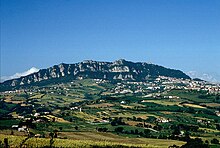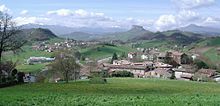Apennines
| Apennines | |
|---|---|
| Highest peak | Corno Grande ( 2912 m slm ) |
| location | Italy , San Marino |
| Coordinates | 42 ° N , 14 ° E |
| Type | Fold Mountains |
| Age of the rock | Alpidian orogeny |
The Apennines (also in the plural the Apennines ; Italian gli Appennini ) is a 1500 km long mountain range in Italy and San Marino , which runs through a large part of both states, mainly in a north-west-south-east direction. Italy's main watershed runs over the Apennines . It is part of the Alpidic mountain system .
The Italian Peninsula is also called the Apennine Peninsula or Apennine Peninsula after this mountain range (the spelling without a hyphen, e.g. Apennine Peninsula , is also common). It is the Italian mainland about south of a line between Genoa and Venice . But there are also other views: Often the southern edge of the Po Valley is seen as the borderline and sometimes the course of the Po river . Because of its shape, the Apennine peninsula is known colloquially as the "Italian boot ".
course


The Apennines begin in northwest Italy and form the continuation of the Ligurian Alps in the Ligurian Apennines . The Col di Cadibona ( 436 m ) forms the border between the Alps and the Apennines . From there the Apennines stretches east over the Apuan Alps to the Adriatic coast , where it turns south and reaches its greatest height in the Abruzzo Apennines with the Gran Sasso d'Italia massif ( 2912 m ).
Further south, the Apennines are divided into individual smaller mountain parts such as the Sila and the Aspromonte and continue in the mountains of northern Sicily .
Classification
Northern Apennines - Appennino settentrionale
- Ligurian Apennines - Appennino ligure
- Tuscan-Emilian Apennines - Appennino tosco-emiliano
- Tuscany-Romagna-Apennines - Appennino tosco-romagnolo
- Apuan Alps
Central Apennines - Appennino centrale
- Umbrian - Markesian Apennines - Appennino umbro-marchigiano
- Abruzzo Apennines - Appennino abruzzese
Southern Apennines - Appennino meridionale
- Samnite Apennines - Appennino sannita
- Campanian Apennines - Appennino campano
- Lucanian Apennines - Appennino lucano
- Calabrian Apennines - Appennino calabro
Sicilian Apennines - L'Appennino Siculo
rock
The Apennines are an alpine chain mountain range that owes its unfolding to the impact of the African against the Eurasian plate . It consists of lime , dolomite rock , sandstone , slate , marl and clay , partly also of crystalline basement .
climate
In the Apennines there is a typical mountain climate with low temperatures, but strong temperature fluctuations and high levels of precipitation. In the hill country and the foothills, the climate is influenced by the Mediterranean, with rainfall of around 800 mm and a clear summer drought. In the subalpine regions, the amount of precipitation rises to over 1300 mm, with a clear west-east difference.
Flora and fauna
The vegetation of the coastal regions extends up to about 600 meters, where it merges into a belt of sweet chestnuts and oaks and even higher conifers . The tree line is around 2000 m.
One endemic animal in the Apennines is the spectacled salamander . The Apennine wolf also lives there . The Bardigiano is the native breed of horse.
Several national parks have been designated in the Apennines:
- Abruzzo, Lazio and Molise National Park
- Foreste Casentinesi National Park
- Monti Sibillini National Park
- Pollino National Park
- Tuscan-Emilian Apennines National Park
traffic
The Apennines are crossed by many motorways, such as the Milan - Genoa ( A7 ), Parma - La Spezia ( A15 ), Bologna - Florence ( A1 ) (Autostrada del Sole) or Pescara - Rome ( A24 / A25 ) routes . Most of the passes are between 500 and 1000 m, some are even higher. The Bologna – Florence railway crosses the mountains in the 18.5 km long Apennine base tunnel opened in 1934 .
Web links
- Literature on the Apennines in the catalog of the German National Library


